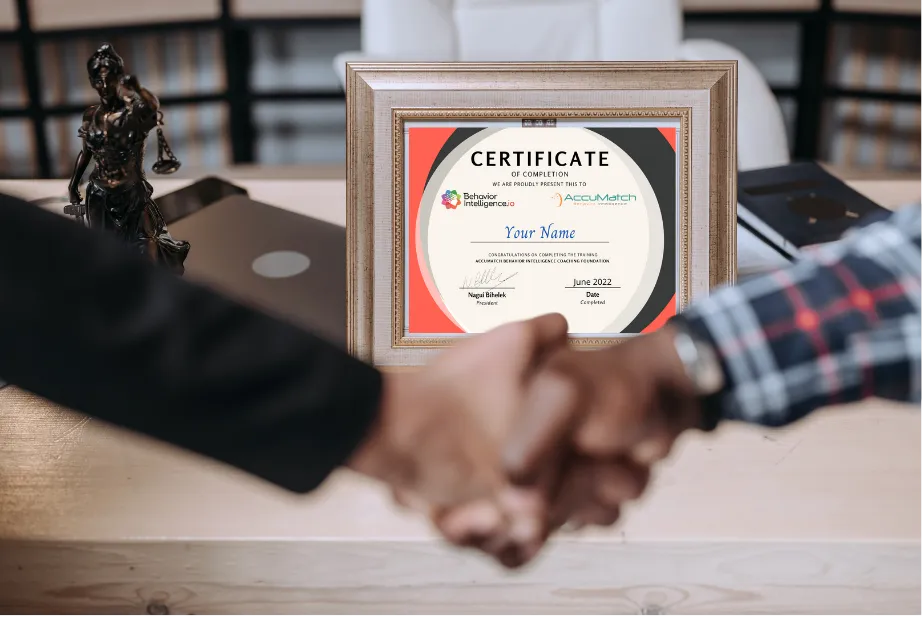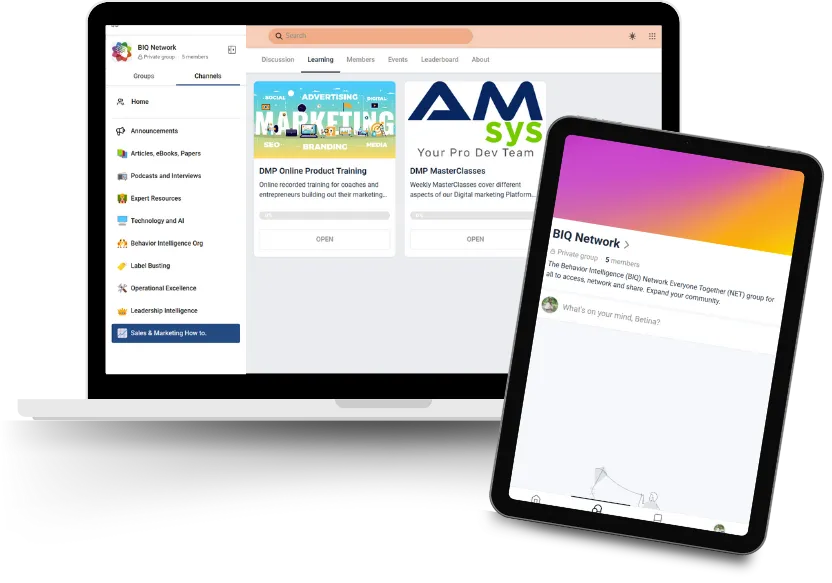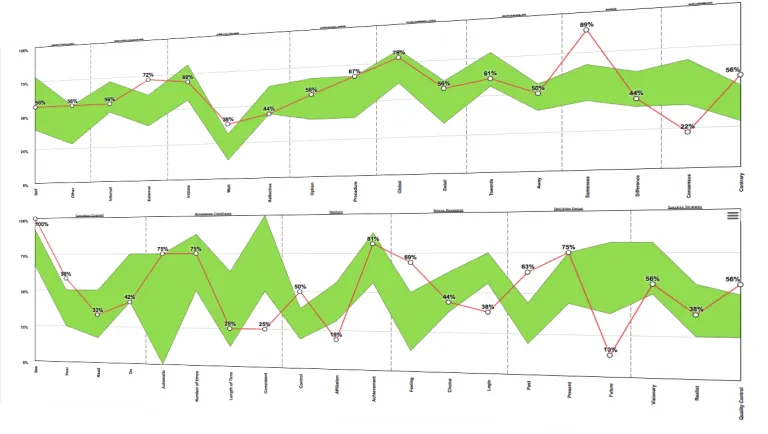Become a Certified Leadership Intelligence Coach
Lead with clarity. Coach with science. Grow with purpose. Powered by Behavior Intelligence (BIQ).

Trusted by:





Leadership today demands more than emotional intelligence. It demands Behavior Intelligence.
Certified credibility
Practical behavior-driven methods
Business growth platform
Global network of professionals
How You’ll Build and Grow

Get Certified
Become a Leadership Intelligence Coach

Master Behavior Intelligence
Train, Practice, Apply

Grow Your Business
Use our tools and support systems
Where are you starting from?
Executive transitioning to coaching?
Experienced coach seeking edge?
Organization building leaders?
Your Complete Coaching Advantage

Certification
Leadership Intelligence, Behavior Intelligence, AccuMatchBI

Business Platform
CRM, Marketing Systems, Templates

Community & Ongoing Growth
Access to BIQ Experts and Peer Network
Real Coaches.
Real Success.

"I’ve been coaching for over a decade, but the BIQ certification completely changed how I work with clients. Understanding their behavior patterns—not just their feelings—gave me a new level of precision. My client retention and referrals have never been higher."
Lena Morales, Executive Coach

"BIQ helped me launch my coaching business fast—with structure, confidence, and real clients."
David Chan, Former VP

"We rolled out BIQ inside our leadership development program. The impact was immediate. Managers became more self-aware, team dynamics improved, and performance conversations finally got real. It’s not just a certification—it’s a competitive edge."
Rachel Owens, Learning & Development Director, UK
Ready to Lead with Intelligence?
Latest From The Blog

Culture In Motion
Building Culture Through Behavior, Not Words
Culture is one of those words that gets thrown around a lot in organizations. Everyone says they have one. You’ll see mission statements and “values” framed beautifully in offices or listed on websites. But here’s the hard truth — if those values aren’t lived out through behavior, they’re just words on a wall.
Real culture is not what’s written.
It’s what’s repeated.
What Culture Really Is
If you look up the definition of culture, it’s “the observable behavior of a group.”
That means culture is what people do, not what they say. It’s visible, consistent, and shared — whether it’s in a family, a team, or a large organization.
When I first started consulting, I noticed a pattern in growing companies: they start with a clear identity — usually a reflection of the founder’s passion and values — but lose it as they scale. Why? Because they forget to translate intent into behavior.
As teams grow and hiring expands beyond the founder’s direct influence, people start bringing their own habits, norms, and expectations. Without systems that protect the behavioral DNA of the organization, that identity starts to fade. And once a company loses its behavioral identity, it loses its direction.
Culture Isn’t Words — It’s Micro Behaviors
Posting values on a wall doesn’t build culture any more than reading a gym poster builds muscle.
Culture is built one micro behavior at a time.
For example:
Collaboration isn’t saying “We work well together.”
It’s pausing in meetings to ask for input, especially from quieter voices.Innovation isn’t “We think outside the box.”
It’s creating a system where people submit new ideas, test prototypes, and get recognized for it.Accountability isn’t “We take ownership.”
It’s calling out mistakes constructively and following through on commitments.
These are not slogans. They’re small, observable actions that add up — day after day — to become a culture.
Every time you act in alignment with your values, you make a deposit into your culture account.
When Words Don’t Match Behavior
Ever notice how people stop seeing the posters in their office after a while? The same thing happens with values. They fade into the background if not actively practiced.
If you allow small breaches — gossip, negativity, missed commitments — without addressing them, you’re giving tacit approval. Every uncorrected behavior reinforces itself.
That’s how culture breaks down.
And the longer it’s left unchecked, the faster it spreads — like a rotten apple in a basket.
So, leaders must step in early. Introduce micro-interventions: short, visible reminders that bring people back to the behaviors you want to strengthen. Ask questions, interrupt unhelpful patterns, and make space to realign.
Culture, after all, is contagious — for better or worse.
How to Build Culture Through Behavior Intelligence
Behavior Intelligence gives leaders the tools to understand, track, and reshape behaviors that drive culture. It’s about identifying patterns — what people actually do — and guiding them toward habits that serve the organization’s goals.
Here’s a six-step framework for doing that:
Make Values Tangible
Translate every value into specific behaviors.
Example: Instead of “Integrity,” define it as “We admit mistakes openly and address them fast.”
Assign Accountability
Give each leader or team member ownership of one value or behavior.
Their job is to keep it alive — to notice when it’s missed and celebrate when it’s seen.
Measure What You Want to Strengthen
What you measure, changes.
Track behaviors, not just attitudes. Use tools like AccuMatch to map and measure your team’s behavior patterns over time.
Recognize and Reward Repetition
Culture solidifies through habit loops — cue, routine, reward.
When people repeat a behavior and see it acknowledged, it becomes part of their automatic response.
Expect Breaks — Then Reset Fast
Under stress, people revert to old habits.
Use those moments to build resilience. Create controlled stress scenarios (like time-boxed projects or hackathons) that strengthen the new habits instead of snapping back to the old ones.
Remember That Culture Lags Behind Action
Behavior changes first. Culture follows.
You might see the shift a month or two later — but stay consistent. People don’t mirror what you say. They mirror what you do.

Culture Starts (and Ends) with Leaders
Leaders are the mirror of the culture. Teams will always take their cues from what leaders tolerate, model, and reward.
If a leader says collaboration is a value but runs meetings like a monologue, the team learns something very different.
If a leader preaches innovation but shuts down new ideas, the culture learns to stay silent.
So, it’s not enough to declare values — you have to live them daily, visibly and consistently.
Some leaders I’ve worked with create monthly “culture talks,” where the team picks one behavior or value and unpacks it:
What does this look like in action?
How are we doing it (or not)?
What can we improve?
These discussions turn abstract ideas into shared rituals — and that’s where culture truly comes alive.
Culture as a Living System
Culture is never “set.” It’s a living system that evolves with every behavior, every hire, every decision.
If you stop nurturing it, it starts drifting — and drift always leads downhill.
The good news? Culture can be designed, measured, and improved.
Behavior Intelligence tools like AccuMatch help organizations map and visualize their cultural strengths and blind spots, making the invisible visible.
When you track, discuss, and celebrate observable behavior, you create a self-reinforcing cycle:
Awareness
Action
Alignment
Achievement
And when that happens, culture isn’t just something you talk about — it’s something you live.
Final Thoughts: Keep Your Culture in Motion
Culture in motion means your values are not static. They move — through behaviors, habits, and the people who live them every day.
If you want a culture of collaboration, innovation, and trust, start by observing what behaviors you’re rewarding now. Then, decide what needs to change — and lead by example.
Because at the end of the day:
People don’t follow mission statements. They follow behavior.
Ready to Build a Culture That Moves?
If you’re ready to turn your values into behavior, explore how Behavior Intelligence and AccuMatch can help you measure, shape, and strengthen your culture.
[Learn more about Leadership Intelligence Certification →]
Subscribe to our Newsletter!
Get the latest insights on coaching, behavior intelligence, & leadership.
Copyright 2025 • All Rights Reserved
Behavior Intelligence Organization is a Division of NLP Profiles Inc.
Terms of Use | Privacy Policy
Subscribe to our Newsletter!
Get the latest insights on coaching, behavior intelligence, & leadership.
Copyright 2025 • All Rights Reserved
Behavior Intelligence Organization is a Division of NLP Profiles Inc.
Terms of Use | Privacy Policy









